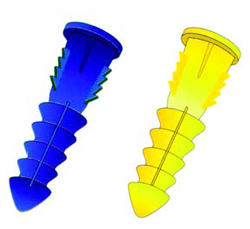Hello,
I have a gate which adjoins the side of my house, with the latch side against my brick exterior wall. When installed several years aqo, the contractor butted a 2x4 against the brick to hold the stationary part of the gate's latch. The board has become loose so I removed it to find the anchor bolts and screws used to anchor the wood to the brick loose enough to pull out by hand. I have no experience in drilling thru such material but this does not look like a good job. My questions are;
Is it ok to drill through brick? One of the anchor bolts was done this way and now the brick is cracked.
How much distance should there be between any anchors drilled into the mortar? For example, if I have a 4" wide piece of wood to anchor into the wall, and drill into a horizontal mortar line, how many holes can I safely drill into that line? This post will need to take a lot of abuse from the 5' wide gate closing onto it.
What is the best type of bolt/screw to use? The original installation used what looked like drywall screws and what I'd called a "headless" lag bolt anchored into the wall.
I read this link which gave a good description of anchors/mollies.
http://www.houserepairtalk.com/f17/hanging-wreath-stone-7675/
I don't know how well I described this, so let me know and I can take some pictures to try and make it clearer.
Thanks for any help.
Jim
I have a gate which adjoins the side of my house, with the latch side against my brick exterior wall. When installed several years aqo, the contractor butted a 2x4 against the brick to hold the stationary part of the gate's latch. The board has become loose so I removed it to find the anchor bolts and screws used to anchor the wood to the brick loose enough to pull out by hand. I have no experience in drilling thru such material but this does not look like a good job. My questions are;
Is it ok to drill through brick? One of the anchor bolts was done this way and now the brick is cracked.
How much distance should there be between any anchors drilled into the mortar? For example, if I have a 4" wide piece of wood to anchor into the wall, and drill into a horizontal mortar line, how many holes can I safely drill into that line? This post will need to take a lot of abuse from the 5' wide gate closing onto it.
What is the best type of bolt/screw to use? The original installation used what looked like drywall screws and what I'd called a "headless" lag bolt anchored into the wall.
I read this link which gave a good description of anchors/mollies.
http://www.houserepairtalk.com/f17/hanging-wreath-stone-7675/
I don't know how well I described this, so let me know and I can take some pictures to try and make it clearer.
Thanks for any help.
Jim







